The situation of rainforests
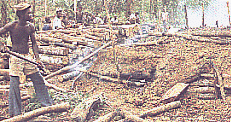
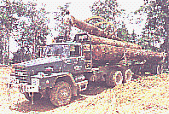 There
are a large number of natural and human-induced factors that impact on
rain forests. Cyclones, forest fires, disease, landslides, and other
natural factors are now of rather minimal influence compared to human
deforestation, such as that caused by logging, road building, building dams and highways
mining, and
large-scale clearing for cattle pasture and other agricultural crops.
Traditional societies practised slash-and-burn cultivation where only
relatively small areas were cleared. When the nutrients in the soils
were depleted after two or three years, the plot was abandoned and
another cleared. Because the plots were small they would be quickly
recolonized by the surrounding forest after abandonment. The large-scale
clearing that now takes place in nearly all rain forest areas is of such
an extent that hundreds of years would probably be needed for natural
recovery to produce anything similar to the original vegetation. As the
ecosystem shrinks, more and more species lose the resources that they need to
survive.
There
are a large number of natural and human-induced factors that impact on
rain forests. Cyclones, forest fires, disease, landslides, and other
natural factors are now of rather minimal influence compared to human
deforestation, such as that caused by logging, road building, building dams and highways
mining, and
large-scale clearing for cattle pasture and other agricultural crops.
Traditional societies practised slash-and-burn cultivation where only
relatively small areas were cleared. When the nutrients in the soils
were depleted after two or three years, the plot was abandoned and
another cleared. Because the plots were small they would be quickly
recolonized by the surrounding forest after abandonment. The large-scale
clearing that now takes place in nearly all rain forest areas is of such
an extent that hundreds of years would probably be needed for natural
recovery to produce anything similar to the original vegetation. As the
ecosystem shrinks, more and more species lose the resources that they need to
survive.
Oil drilling
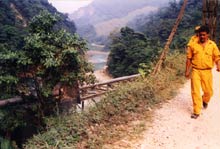 Oil drilling is one of the main reasons that rainforests
around the world are being destroyed. Oil
companies go to the rainforest to drill for oil that is found beneath
the ground. This oil or petroleum comes from the fossils of dinosaurs
and plants that lived on earth millions of years ago. It then gets made
into fossil fuels, including oil, gas, and coal. Oil is also used to
make plastic bags, bottles, and cups, and synthetic fabrics like
polyester and nylon.
Oil drilling is one of the main reasons that rainforests
around the world are being destroyed. Oil
companies go to the rainforest to drill for oil that is found beneath
the ground. This oil or petroleum comes from the fossils of dinosaurs
and plants that lived on earth millions of years ago. It then gets made
into fossil fuels, including oil, gas, and coal. Oil is also used to
make plastic bags, bottles, and cups, and synthetic fabrics like
polyester and nylon.
Large oil companies use millions of acres of rainforest to get oil.
They want this oil so they can sell it to make a lot of money. There is
nothing wrong with making money, but when oil companies destroy the
rainforests to make money they destroy not only the trees, but also the
lives of the animals and people who live in the rainforest.
Oil drilling hurts the rainforests because many trees are chopped
down to make room for oil roads, oil pipelines, and oil machinery. When
these trees are destroyed, all the animals that lived in those trees or
depended on them for food are suddenly homeless. Without their forest
home, many animal species face extinction, which means they could
disappear forever like the dinosaurs.
 Another
problem is that when companies drill for oil in the rainforests, the oil
often gets spilled onto the soil and into the rivers and streams. This
poisons the water and the homeland of the people who live in the
rainforest. Many of these indigenous people-people whose families have
lived in the rainforest for thousands of years-become very sick from the
pollution. Some of these indigenous people even die because of oil
drilling in their homeland.
Another
problem is that when companies drill for oil in the rainforests, the oil
often gets spilled onto the soil and into the rivers and streams. This
poisons the water and the homeland of the people who live in the
rainforest. Many of these indigenous people-people whose families have
lived in the rainforest for thousands of years-become very sick from the
pollution. Some of these indigenous people even die because of oil
drilling in their homeland.
Not only does oil drilling poison the land and rivers in the
rainforest, but it also creates air pollution once it's turned into
gasoline. Burning fossil fuels like gasoline by driving cars, buses and
airplanes, makes our air very dirty and unhealthy to breathe. Many
people around the world get sick from breathing in too much of this smog
or dirty air.
Burning oil and gasoline also makes the planet get warmer, which is a
very big problem. This global warming creates climate change. This means
that weather patterns around the world start to change in dangerous
ways. Winters get colder, summers get hotter, and hurricanes and
tornadoes get fiercer and more frequent.
Cattle
ranching
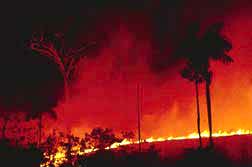 One of the main causes of
rainforest destruction in Central and South America is cattle ranching. Cattle
ranchers slash and burn the rainforest to make room for cattle pastures. First,
the ranchers cut down the trees and set the forest on fire. Then they plant
grass and bring in cows to feed on the grass. When the cows are grown, they are
slaughtered and turned into cheap beef. The beef is used in fast-food
hamburgers, frozen meat products, and canned pet food.
One of the main causes of
rainforest destruction in Central and South America is cattle ranching. Cattle
ranchers slash and burn the rainforest to make room for cattle pastures. First,
the ranchers cut down the trees and set the forest on fire. Then they plant
grass and bring in cows to feed on the grass. When the cows are grown, they are
slaughtered and turned into cheap beef. The beef is used in fast-food
hamburgers, frozen meat products, and canned pet food.
It takes a lot of rainforest land, water, and energy to make a fast-food
hamburger. As a matter of fact, fifty-five square feet of rainforest is
destroyed for every quarter pound hamburger that comes from a cleared
rainforest. That's the size of a small kitchen! Not only that, but since the
soil in the rainforest does not contain many nutrients, after a few years of
cattle ranching it becomes very difficult to grow anything on the land¡X even
grass. What was once a beautiful, lush, living rainforest becomes a dry,
desert-like wasteland. When this happens, even more rainforest is slashed and
burned for cattle ranching.
Clearing the rainforest to produce beef also destroys the homes of the
animals that live in the rainforest. Without their rainforest homes, many of
these animals simply cannot survive and may become extinct. When an animal
becomes extinct, it disappears forever like the dinosaurs.
Raising cattle for beef not only damages the rainforests in Central and South
America, it also impacts the environment closer to home. Over half of the water
used in the United States goes to beef production. In fact, it takes an average
of 2,500 gallons of water to produce a single pound of red meat. That's as much
water as a typical family uses in a month! With the amount of water it takes to
produce one pound of red meat, farmers can grow up to one hundred pounds of
grain, which makes a lot of bread, pasta, and cereal. One pound of beef can only
feed four people for one lunch, whereas one hundred pounds of grain can feed
four people for a month!
Raising cows for beef¡Xwhether in rainforest countries or the United
States¡Xalso adds to climate change or global warming. It takes a lot of fossil
fuels (oil, coal, and gasoline) to raise cows, slaughter them, freeze the meat,
ship it overseas or across the country, and then transport it to grocery stores
and restaurants. The burning of fossil fuels creates a greenhouse gas called
carbon dioxide. When cows digest their food, they also release a greenhouse gas
called methane. These greenhouse gases trap heat from the sun close to the
Earth's surface. When too much heat is trapped, it causes the planet to warm up,
which in turn causes dangerous changes in the weather. For instance, less rain
may fall in the rainforests, making it difficult for all the trees, plants, and
animals that depend on rain to survive. Climate change is a very big problem
facing the rainforests and our planet. We must do all we can to stop it from
getting worse. One easy way to do that is to eat less red meat!
Logging
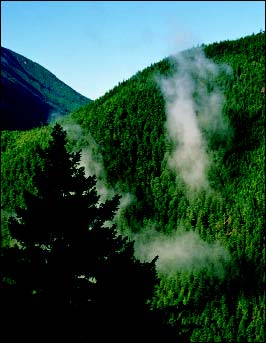 Wood is something we all use in our daily lives. Wood gets made into things
like paper products, furniture, buildings, pencils, rayon fabric, photographic
film, and even food additives that end up in cheeses, cake mixes, and ice cream!
Much of the wood we use for these products comes from very old trees that live
in ancient rainforests. These ancient, or old growth, rainforests have been
standing for hundreds and even thousands of years. They are home to millions of
types of animals, plants, insects-and even people! When old growth forests get
logged to make wood products for us to use, many animal species lose their home,
or habitat. Sometimes these animal species become extinct, which means they
disappear forever like the dinosaurs. Many native or indigenous peoples also
lose their land where their families have lived for thousands of years.
Wood is something we all use in our daily lives. Wood gets made into things
like paper products, furniture, buildings, pencils, rayon fabric, photographic
film, and even food additives that end up in cheeses, cake mixes, and ice cream!
Much of the wood we use for these products comes from very old trees that live
in ancient rainforests. These ancient, or old growth, rainforests have been
standing for hundreds and even thousands of years. They are home to millions of
types of animals, plants, insects-and even people! When old growth forests get
logged to make wood products for us to use, many animal species lose their home,
or habitat. Sometimes these animal species become extinct, which means they
disappear forever like the dinosaurs. Many native or indigenous peoples also
lose their land where their families have lived for thousands of years.
Some logging companies say that they replant the trees they cut. While
planting trees is always a good thing to do, we must remember that planting
trees in an area that's been clearcut (this means that almost every single tree
in the area was cut down) is not the same as planting a forest. A forest is much
more than just the trees it contains. While it is possible for a company to
replant trees, it is impossible for the company to replant an ancient forest
full of all the plants, animals, insects, and people that once lived there.
Rainforests are being destroyed at a staggering rate. According to
the National Academy of Science, at least 50 million acres a year are
lost. Each second a
rainforest area the size of a football field is destroyed or damaged. All the primary rainforests in India, Bangladesh, Sri Lanka and Haiti
have been destroyed already. The Ivory Coast rainforests have been
almost completely logged. The Philippines and Thailand lost 55% and 45% of its forest between
1960 and 1985 respectively. Four-fifths of the nutrients in the rainforests are in the
vegetation. This means that the soils are nutrient-poor and become
eroded and unproductive within a few years after the rainforest is
cleared.
¡@
| COUNTRY (in sq km) |
ORIGINAL EXTENT OF FOREST COVER |
PRESENT EXTENT OF PRIMARY FOREST COVER |
CURRENT AMOUNT OF ANNUAL DEFORESTATION (in
sq km /% per year) |
| Bolivia (1,098,581) |
90,000 |
45,000 |
1,500 (2.1%) |
| Brazil (8,511,960) |
2,860,000 |
1,800,000 |
50,000 (2.3%) |
| C. America (522,915) |
500,000 |
55,000 |
3,300 (3.7%) |
| Columbia (1,138,891) |
700,000 |
180,000 |
6,500 (2.3%) |
| Congo (342,000) |
100,000 |
80,000 |
700 (.8%) |
| Ecuador (270,670) |
132,000 |
44,000 |
3,000 (4.0%) |
| Indonesia (1,919,300) |
1,220,000 |
530,000 |
12,000 (1.4%) |
| Cote D'Ivoire (322,463) |
160,000 |
4,000 |
2,500 (15.6%) |
| Laos (236,800) |
110,000 |
25,000 |
1,000 (1.5%) |
| Madagascar (590,992) |
62,000 |
10,000 |
2,000 (8.3%) |
| Mexico (1,967,180) |
400,000 |
110,000 |
7,000 (4.2%) |
| Nigeria (924,000) |
72,000 |
10,000 |
4,000 (14.3%) |
| Philippines (299,400) |
250,000 |
8,000 |
2,700 (5.4%) |
| Thailand (513,517) |
435,000 |
22,000 |
6,000 (8.4%) |
 The Earth's species are
also dying out at an alarming rate, up to 1000 times
faster than their natural rate of extinction. By carefully examining
fossil records and ecosystem destruction, some scientists estimate that as many
as 137 species disappear from the Earth each day, which adds up to an astounding
50,000 species disappearing every year.
The Earth's species are
also dying out at an alarming rate, up to 1000 times
faster than their natural rate of extinction. By carefully examining
fossil records and ecosystem destruction, some scientists estimate that as many
as 137 species disappear from the Earth each day, which adds up to an astounding
50,000 species disappearing every year.
When rainforests are destroyed, animals living outside the tropics suffer as
well. Songbirds, hummingbirds, warblers and thousands of other North American
birds spend their winters in rainforests, returning to the same location year
after year. Less return north each spring, as few make it through the winter
because their habitat has been destroyed. Pollution from mining has killed fish populations in the mighty Amazon River.
Many Indigenous people, who have depended on these fish for centuries, have
become sick from the poisoned fish. For some species, especially those known to exist only in limited, specific
areas, measuring the destruction rates of their habitat can lead to estimates of
the species' extinction rates. Many of these projected extinctions can be turned
around, however, but only with restoration of the habitats.
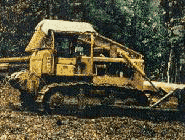 Many indigenous people survive directly off of the resources found in the
rainforests. They eat wild game, use the plants for food and medicine, and may
identify certain species as a sacred and essential part of their heritage. When
these resources are destroyed, the people lose their homes, their food, and
their very culture. And they may be forced to look to protected, endangered
areas of forest for shelter and food, leading to further destruction and
extinction.
Many indigenous people survive directly off of the resources found in the
rainforests. They eat wild game, use the plants for food and medicine, and may
identify certain species as a sacred and essential part of their heritage. When
these resources are destroyed, the people lose their homes, their food, and
their very culture. And they may be forced to look to protected, endangered
areas of forest for shelter and food, leading to further destruction and
extinction.
Introduced species also wipe out
many indigenous species. Nearly 20% of known endangered vertebrates are
threatened by introduced species. When humans bring an alien species
into an ecosystem, that species may take over niches that other species
had occupied. They also might change the ecosystem enough to indirectly
force out native species or bring with them diseases to which the
natives have no immunity. Especially on islands, where species have
evolved in isolation and have not dealt with adapting to newcomers, the
original inhabitants may be unable to adapt and survive.
Over-consumption
and international trade further endanger certain species. In Africa,
commercial hunting is responsible for putting 1/3 of the currently
threatened primary forest at risk. Species populations can also shrink
when local people are forced by habitat destruction to rely on a smaller
area for their food needs, or when a certain species becomes popular on
the international market. People trap or kill animals and ship them to
other countries, where they are taken as pets or used to make other
products. Once a species becomes rare or protected, the profit in
smuggling can increase; international illegal wildlife trade is a $2-3
billion a year business.
¡@
| class |
critically endangered |
endangered |
vulnerable |
total threatened |
extinct |
| Mammals |
169 |
315 |
612 |
1096 |
89 |
| Birds |
168 |
235 |
704 |
1107 |
108 |
| Reptiles |
41 |
59 |
153 |
253 |
21 |
| Amphibians |
18 |
31 |
75 |
124 |
5 |
| Insects |
44 |
116 |
377 |
537 |
73 |
| Other animals |
471 |
423 |
1194 |
2088 |
343 |
Tropical rainforests contain at least half of the Earth's species.
The incredible diversity of the rainforests means
that most species have evolved to inhabit very specialized niches in their
environment; when humans disrupt that environment, many species cannot survive.
Because species depend on each other in a complicated web of relationships,
changing just one part of that web harms the entire ecosystem: as people destroy
or significantly change the rainforests, certain species die out, and as they go
extinct, other species die out, which in turn leads to further breakdown of the
ecosystem. This breakdown of rainforest ecosystems will likely lead to the
disappearance of up to 10% of the world's species within the next 25 years
unless we act to stop it.
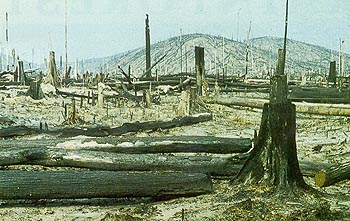 The six hottest years of the century occurred in the last decade, and global
temperatures are beginning to rise. This appears to be the result of the
greenhouse effect caused by the millions of tons of carbon dioxide (CO2) we discharge into the atmosphere. Tropical
rainforests are especially good at trapping CO2. Yet trees that are cut down
cannot act as carbon traps, and when they are burned more carbon is released
into the air which of course magnifies the problem.
The six hottest years of the century occurred in the last decade, and global
temperatures are beginning to rise. This appears to be the result of the
greenhouse effect caused by the millions of tons of carbon dioxide (CO2) we discharge into the atmosphere. Tropical
rainforests are especially good at trapping CO2. Yet trees that are cut down
cannot act as carbon traps, and when they are burned more carbon is released
into the air which of course magnifies the problem.



 There
are a large number of natural and human-induced factors that impact on
rain forests. Cyclones, forest fires, disease, landslides, and other
natural factors are now of rather minimal influence compared to human
deforestation, such as that caused by logging, road building, building dams and highways
mining, and
large-scale clearing for cattle pasture and other agricultural crops.
Traditional societies practised slash-and-burn cultivation where only
relatively small areas were cleared. When the nutrients in the soils
were depleted after two or three years, the plot was abandoned and
another cleared. Because the plots were small they would be quickly
recolonized by the surrounding forest after abandonment. The large-scale
clearing that now takes place in nearly all rain forest areas is of such
an extent that hundreds of years would probably be needed for natural
recovery to produce anything similar to the original vegetation. As the
ecosystem shrinks, more and more species lose the resources that they need to
survive.
There
are a large number of natural and human-induced factors that impact on
rain forests. Cyclones, forest fires, disease, landslides, and other
natural factors are now of rather minimal influence compared to human
deforestation, such as that caused by logging, road building, building dams and highways
mining, and
large-scale clearing for cattle pasture and other agricultural crops.
Traditional societies practised slash-and-burn cultivation where only
relatively small areas were cleared. When the nutrients in the soils
were depleted after two or three years, the plot was abandoned and
another cleared. Because the plots were small they would be quickly
recolonized by the surrounding forest after abandonment. The large-scale
clearing that now takes place in nearly all rain forest areas is of such
an extent that hundreds of years would probably be needed for natural
recovery to produce anything similar to the original vegetation. As the
ecosystem shrinks, more and more species lose the resources that they need to
survive.
 Oil drilling is one of the main reasons that rainforests
around the world are being destroyed. Oil
companies go to the rainforest to drill for oil that is found beneath
the ground. This oil or petroleum comes from the fossils of dinosaurs
and plants that lived on earth millions of years ago. It then gets made
into fossil fuels, including oil, gas, and coal. Oil is also used to
make plastic bags, bottles, and cups, and synthetic fabrics like
polyester and nylon.
Oil drilling is one of the main reasons that rainforests
around the world are being destroyed. Oil
companies go to the rainforest to drill for oil that is found beneath
the ground. This oil or petroleum comes from the fossils of dinosaurs
and plants that lived on earth millions of years ago. It then gets made
into fossil fuels, including oil, gas, and coal. Oil is also used to
make plastic bags, bottles, and cups, and synthetic fabrics like
polyester and nylon. Another
problem is that when companies drill for oil in the rainforests, the oil
often gets spilled onto the soil and into the rivers and streams. This
poisons the water and the homeland of the people who live in the
rainforest. Many of these indigenous people-people whose families have
lived in the rainforest for thousands of years-become very sick from the
pollution. Some of these indigenous people even die because of oil
drilling in their homeland.
Another
problem is that when companies drill for oil in the rainforests, the oil
often gets spilled onto the soil and into the rivers and streams. This
poisons the water and the homeland of the people who live in the
rainforest. Many of these indigenous people-people whose families have
lived in the rainforest for thousands of years-become very sick from the
pollution. Some of these indigenous people even die because of oil
drilling in their homeland.
 One of the main causes of
rainforest destruction in Central and South America is cattle ranching. Cattle
ranchers slash and burn the rainforest to make room for cattle pastures. First,
the ranchers cut down the trees and set the forest on fire. Then they plant
grass and bring in cows to feed on the grass. When the cows are grown, they are
slaughtered and turned into cheap beef. The beef is used in fast-food
hamburgers, frozen meat products, and canned pet food.
One of the main causes of
rainforest destruction in Central and South America is cattle ranching. Cattle
ranchers slash and burn the rainforest to make room for cattle pastures. First,
the ranchers cut down the trees and set the forest on fire. Then they plant
grass and bring in cows to feed on the grass. When the cows are grown, they are
slaughtered and turned into cheap beef. The beef is used in fast-food
hamburgers, frozen meat products, and canned pet food.
 Wood is something we all use in our daily lives. Wood gets made into things
like paper products, furniture, buildings, pencils, rayon fabric, photographic
film, and even food additives that end up in cheeses, cake mixes, and ice cream!
Much of the wood we use for these products comes from very old trees that live
in ancient rainforests. These ancient, or old growth, rainforests have been
standing for hundreds and even thousands of years. They are home to millions of
types of animals, plants, insects-and even people! When old growth forests get
logged to make wood products for us to use, many animal species lose their home,
or habitat. Sometimes these animal species become extinct, which means they
disappear forever like the dinosaurs. Many native or indigenous peoples also
lose their land where their families have lived for thousands of years.
Wood is something we all use in our daily lives. Wood gets made into things
like paper products, furniture, buildings, pencils, rayon fabric, photographic
film, and even food additives that end up in cheeses, cake mixes, and ice cream!
Much of the wood we use for these products comes from very old trees that live
in ancient rainforests. These ancient, or old growth, rainforests have been
standing for hundreds and even thousands of years. They are home to millions of
types of animals, plants, insects-and even people! When old growth forests get
logged to make wood products for us to use, many animal species lose their home,
or habitat. Sometimes these animal species become extinct, which means they
disappear forever like the dinosaurs. Many native or indigenous peoples also
lose their land where their families have lived for thousands of years.
 The Earth's species are
also dying out at an alarming rate, up to 1000 times
faster than their natural rate of extinction. By carefully examining
fossil records and ecosystem destruction, some scientists estimate that as many
as 137 species disappear from the Earth each day, which adds up to an astounding
50,000 species disappearing every year.
The Earth's species are
also dying out at an alarming rate, up to 1000 times
faster than their natural rate of extinction. By carefully examining
fossil records and ecosystem destruction, some scientists estimate that as many
as 137 species disappear from the Earth each day, which adds up to an astounding
50,000 species disappearing every year.
 Many indigenous people survive directly off of the resources found in the
rainforests. They eat wild game, use the plants for food and medicine, and may
identify certain species as a sacred and essential part of their heritage. When
these resources are destroyed, the people lose their homes, their food, and
their very culture. And they may be forced to look to protected, endangered
areas of forest for shelter and food, leading to further destruction and
extinction.
Many indigenous people survive directly off of the resources found in the
rainforests. They eat wild game, use the plants for food and medicine, and may
identify certain species as a sacred and essential part of their heritage. When
these resources are destroyed, the people lose their homes, their food, and
their very culture. And they may be forced to look to protected, endangered
areas of forest for shelter and food, leading to further destruction and
extinction.


